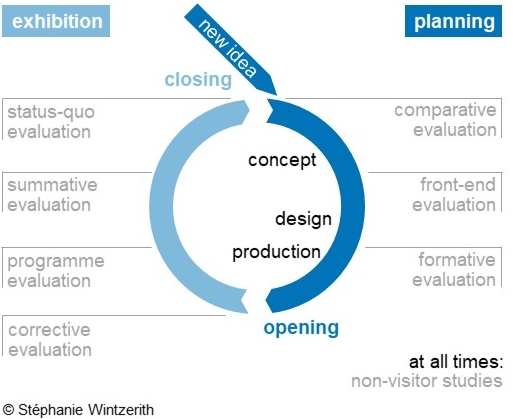Types of evaluation
Different phases of the planning process
An evaluation can be extremely useful at any step of the project’s lifecycle. The planning and implementation of a cultural project is generally a process encompassing a long period of time. The range of information required varies according to the project maturity. At every stage of the undertaking, the appropriate evaluation – the overall term for the types of surveys described below – can provide the necessary data.
In a museum for instance, visitor studies are commonly carried out while the exhibition is open to the public. Nevertheless, visitor research could also be very beneficial if carried out before, i.e. during the planning process.
Evaluation in the life-cycle of an exhibition

Types of evaluation for cultural projects
Though the different types of evaluations described below have been developed mainly for museums and exhibitions, they may also apply to other kinds of cultural offers.
|
Comparative study A comparative study is usually done at the very beginning of the planning process. Its purpose is to give an overview of ideas and expectations currently circulating about the topic in question, and, where applicable, to present a comparison of achievements. This information is useful to draft a first concept for the project. The methods used are for example bibliographical research, expert panels or focus groups |
|
|
Market and potential analysis At an early stage of the planning process, it might be useful to check whether the potential users/visitors have any interest in the planned project in the first place. Though the methods used are generally quantitative, they may also be completed by qualitative methods such as focus groups or expert panels. |
|
|
Front-end evaluation A front-end evaluation gathers data about views, expectations, interests and knowledge of potential visitors. It is conducted relatively early in the planning process, so as to find answers to specific questions soon enough and have the possibility to integrate the implementation of the findings in the project itself. The studies are mainly quantitative surveys (questionnaires), but might also be refined by a qualitative study. |
|
|
Formative evaluation During the setting up of an exhibition for instance, a certain number of questions may arise concerning the implementation of concepts. Mock-ups and prototypes of exhibits, hands-on displays or texts etc. are specially made for that purpose and presented to respondents, who test them. The mock-ups are optimized until they fully convince the respondents as well as the project leader. These are qualitative studies in most cases. |
|
|
Summative evaluation A summative evaluation analyses the implementation of a cultural project. Visitors or users are asked for their appraisal and opinion. This is the most common form of evaluation. Its purpose is to find out the audiences’ constitution and to assess their satisfaction. Thus, the visitors’ or users’ feedback can be included into the final project assessment and some conclusions drawn for future projects. It is usually a quantitative survey, though qualitative methods could also help deepen the analysis. |
|
|
Remedial evaluation A remedial evaluation is carried out during the operative phase of the project. Unlike the summative evaluation, its focus is not on the post-processing. Its objective is to identify as quickly as possible the weaknesses of the project and wherever possible to rectify them. Qualitative data is favoured in many cases. |
|
|
|
Status quo evaluation The planned restructuring of a cultural offering that has been maintained over a very long period of time gives a good opportunity to carry out a complete appraisal. Its strengths and weaknesses should be identified as well as the particularly popular elements and those worthy of being preserved. Both quantitative and qualitative methods could be used for this appraisal. |
Structural themes
Broader questions often arise independently of any actual project planning process. Those could also be answered with an evaluation:
|
Non-visitor study Such a study is conducted outside the cultural institution. It addresses people who have visited the institution in the past and people who have not – or not yet. The quantitative approach enables, for example, the assessment of the degree of awareness of the population, their interests in this institution or the identification of the existing entrance barriers. |
|
|
Potential analysis and image study These are specific types of non-visitor studies. Their aim is to assess the degree of awareness or the image the institution has with the general public. It usually consists in a quantitative survey but could also comprise qualitative elements. |
|
|
Members‘ or subscribers‘ survey Wherever a specific affiliation is given, such as for example membership in an association or subscription to a recurrent cultural offer, the evaluation focusses on the description of this particular group of people, its connection to the institution and its satisfaction with the offer. The sample is notably taken out of an existing file of previously known potential respondents. Quantitative data is favoured, provided the sample size allows it. |
Back to core business
